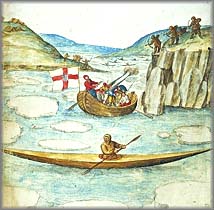
|
 few days later, on the south shore of Frobisher Bay, the English visited an abandoned Inuit camp where they found a few items of European clothing. Although this camp was more than 200 kilometres from where the five sailors had disappeared the previous summer, they assumed that the clothing belonged to these countrymen. few days later, on the south shore of Frobisher Bay, the English visited an abandoned Inuit camp where they found a few items of European clothing. Although this camp was more than 200 kilometres from where the five sailors had disappeared the previous summer, they assumed that the clothing belonged to these countrymen.
A battle plan was formed, and in a subsequent attack on a nearby settlement, five or six Inuit were killed and one Englishman was seriously wounded. A woman and her infant son were captured and taken hostage. The English aptly named the location "Bloody Point."
|
 |
Painting by John White showing the skirmish between the Inuit and Frobisher's men.
Reproduced by permission of the Trustees of the British Museum
|
|
"And thervpon indeede our men whiche were in the boates...forced them to put themselues ashoare vpon a point of lande within the said sound (which vpon the occasion of the slaughter there was since named the Bloudie point) whevnto our men so speedily followed, that they hadde little leysure lefte them to make any escape....And desperately retorning vpon our men, resisted them manfullye in their landing, so long as theyr arrows and dartes lasted, & after gathering vp those arrows which our men shot at them, yea, and plucking our arrowes out of their bodies, encountred afresh againe, and maintained their cause, vntil both weapons and life vtterly failed them."
(George Best's account of the 1577 voyage)

|
|
The English now had three hostages: a man, a woman and her infant child. They sailed away to the north shore of Frobisher Bay, where they had found a small island containing much black rock which they thought was gold ore. They named it the "Countess of Warwick's Island" and began mining.
|


|

